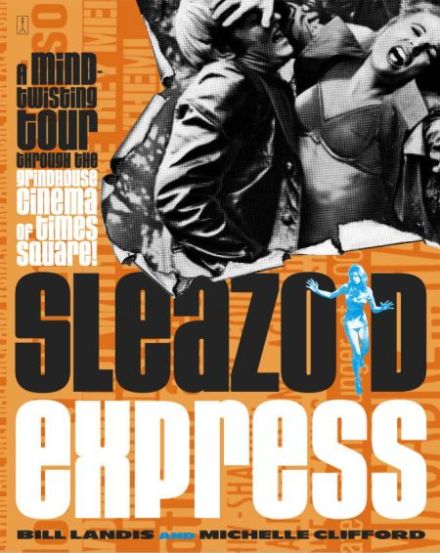Typical of most discussions of sexuality and deviance in America, most of the writing about 1960s – 1980s era Times Square utilizes a variety of distancing techniques, including condemnation, mindless celebration, irony, or a dry “ethnographic” approach. However different these styles appear to be on the surface, they all share the fact that most of the authors of these texts are outsiders, writing about the period as observers and “researchers.” Bill Landis’s “Sleazoid Express” and Michelle Clifford’s “Metasex” were brilliant self-published monographs (though Clifford and Landis contributed significantly to each other’s publications) that were different not only because they personally knew many of the people of this world, but they applied a human touch missing from everything else written about this subject.
“Sleazoid Express” and “Metasex” focused on the films and, more importantly, the people who lived, worked, and breathed the porn/vice lifestyle during this period. Landis and Clifford not only offered some of the most in-depth and insightful criticism of the exploitation films that played Times Square, but also profiled the filmmakers, actors, theaters, employees, and customers. The reviews were terrific, because they didn’t distinguish between art and exploitation. The denominator that mattered was that a film told the truth.
The personal profiles were where Landis and Clifford excelled, mainly due to their ability to humanize their subjects and not turn them in to martyrs, icons, or creeps. There were rarely any heroes and villains in Landis’s and Clifford’s profiles and if there were villains, they were typically hypocrites, liars, and people who channelled their own vices/deviance into crusades or schemes against the people they are outwardly condemning. The depth and complexity with which Landis and Clifford wrote about their subjects not only separated their writing from everyone else’s, but also raised it to the level of art.
Landis and Clifford had a unique perspective and sensitivity towards telling the truth about what they saw and experienced and the people they knew from that world. Their approach also complicated one’s reaction to such material, since one was never sure whether to condemn, admire, or feel sorry for the people they wrote about. It also didn’t fit into any of the typical categories much of this writing typically falls into: 1) the porn is evil perspective; 2) the mindless “sex positive” perspective; 3) the smart-alecky “look at the freaks” perspective, or; 4) the academic “ethnographic” perspective.
This is not to say Landis’s and Clifford’s work lacked humor, but it’s difficult to approach this material in any kind of smart-alecky fashion once certain images are burned into one’s head. It’s incredibly powerful and complex stuff.
Landis and Clifford were the only two people documenting this era as it really happened, since everyone else who lived through the things they did are either dead, in prison, burned out, or MIA. Sadly, Landis passed away in 2008. Fortunately, Clifford is still around and in 2011, Clifford appeared on an episode of the stellar Projection Booth podcast during their Kenneth Anger special (Clifford and Landis co-wrote the brilliant Kenneth Anger biography “Anger” in 1995).
http://projection-booth.blogspot.com/2011/09/episode-27-kenneth-anger-magick-lantern.html
Also, a version of Clifford’s infamous Jamie Gillis profile (from Metasex #4) is included in the 2011 anthology “From the Arthouse to the Grindhouse: Highbrow & Lowbrow Transgression in Cinema’s First Century” by John Cline and Robert G. Weiner. You can still find “Anger” and the “Sleazoid Express” books Landis and Clifford wrote in 2002 on Amazon and are worth reading. And if you can find copies of the original “Sleazoid Express” or “Metasex” monographs, they’re definitely worth tracking down.

